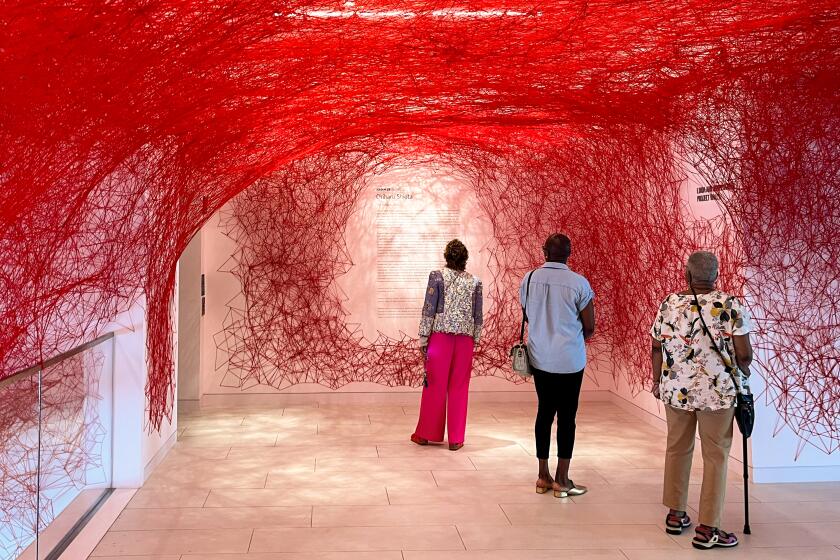Review: A Getty show rummages around in Edouard Manet’s private shadows
Edouard Manet’s imposing 1882 painting of a winsome, weary barmaid at the Folies-Bergère has cast a long shadow across the final years of the artist’s life. Manet died the next year, at age 51, but this challenging late work is commonly grouped with the radically disruptive canvases “Luncheon on the Grass” and “Olympia” that launched his remarkable career two decades before.
A surprising new exhibition at the J. Paul Getty Museum looks away from “A Bar at the Folies-Bergère” and instead goes rummaging around in the shadows cast by that great, optically disorienting painting. Unexpected pleasures turn up, along with unforeseen insights.
Chief among them: Manet’s grandest masterpieces operate on a public scale that has contributed to obscuring the more personal, private and even domestic qualities that take center stage in this exhibition.
Case in point: The final room features seven small paintings of crystal vases filled with ripe peonies, moss roses and lilacs. All were painted in the last year of Manet’s life. Little flower paintings aren’t often an exhibition’s grand finale, but together these will leave you gasping.
The flowers, simply set on tabletops before monochrome fields, have been cut and removed from their home in nature and arranged within delicate glass — civilized, one might say. Artistry over nature is further emphasized by exposed movements of Manet’s paint-loaded brush to describe petals, leaves and light glinting off crystal.
“A Bar at the Folies-Bergère” has confounded critics because the big mirror reflection behind the bar is out of whack, refusing to line up directly with what’s in front of it. In the little flower vases, this optical disruption is distilled into the abrupt visual misalignment of a flower’s stem entering water.
Other still lifes show a small basket of ripe strawberries, a bundle of white asparagus, some purple plums on a purple tablecloth or a puffy brioche decorated with a pink rose, as if it were a hat. The succulent compositions openly evoke the still life paintings of Jean-Siméon Chardin, French master of the century prior to Manet’s.
Manet trained in the studio of the grand history painter Thomas Couture. But these creamy blossoms, fruits and vegetables find their memory of past glories in art rather than in epic events of classical history or myth.
The ripe fruits and flowers will not last long. An aroma of impending death widens the eye to soak up glorious beauty, while producing them in paint stops time in its tracks. Manet’s last years were wracked with pain as he suffered the debilitating effects of the tertiary syphilis he certainly knew would kill him. His gangrenous leg was amputated on April 30, 1883, and 10 days later he was dead.
His acute vision, however, continues to inspire new art today. It turns up underpinning the optically extravagant still life paintings of New York artist Janet Fish, and it is closely observed in the luxurious little tabletop pictures by Los Angeles painter Dan McCleary.
The exhibition was organized jointly by Getty curators Scott Allan and Emily A. Beeny and by Gloria Groom of the Art Institute of Chicago, where it had its debut in the summer. All but a few of about 50 paintings are of modest size, with several of the luscious still life subjects under a foot on each side. There’s also a selection of drawings and watercolors executed on the pages of letters, further personalizing correspondence, along with numerous pastels.
A new urban dynamism drove the late 19th-century revolution in French art, and that public stage generally gets the focus. But the public street, park or nightclub is not the only place where modern life plays out. Manet’s buddy Charles Baudelaire, the disputatious journalist, poet and art critic, described artists’ emerging role as being painters of modern life, and urbanity seeped into many private nooks and crannies.
The show is organized into five sections.
“La Vie Moderne” recalls an 1880 Manet solo show sponsored by a period fashion magazine of that name. “Portraits of an Era” parades modish men and women. “The Four Seasons Project” was a never-finished series using passing seasonal styles of fashion, rather than conventional shifts in nature, as emblems of time’s passage. “Manet at Bellevue” brings us to the spa where the artist went (unhappily) for medical treatments. Finally, the show closes with “Flowers, Fruits, and Gardens.”
The curatorial inspiration for this deep dive into neglected territory was the Getty’s 2014 acquisition of “Jeanne (Spring),” one of two completed works from the four-seasons project. It’s an expertly handled profile portrait of a fashionable young woman in a floral dress and ruche-trimmed floral bonnet secured by a big black bow. A parasol rests on her shoulder as she passes before a profusion of leafy greenery beneath a vivid slice of blue sky.
She’s Eve in the garden after the fall, looking quite smart. A 19th-century “Gigi” or Belle Époque Audrey Hepburn, “Jeanne (Spring)” is the epitome of the modern Parisienne, a chic woman defining emergent mass taste.
Notably, the painting was a hit with critics and the public alike when shown at the 1882 Salon, a public venue not always hospitable to Manet’s efforts. Its acclaim far outstripped his other contribution to the show — yes, the splendid “A Bar at the Folies-Bergère,” mocked at the time as fatally flawed yet regarded today as his final masterpiece.
It’s worth comparing the 1881 portrait, which shows actress Jeanne Demarsy as a clever personification of spring, with Manet’s august 1880 picture of his close friend from childhood Antonin Proust, journalist and politician. (Proust owned “Jeanne (Spring).”) Dressed head to toe in dark blue-black, from top hat to frock coat, before an imposing field of deep brown, he stands with right hand on hip and left hand resting on a walking stick.
The dark chromatic gravity is lightened by deft brushwork — parted salt-and-pepper whiskers, rose boutonniere, bursts of white collar and sleeves emerging from the blackness, a wavering line of coat trim down the middle and, especially, the explosive spray of a glove dangling from Proust’s left hand. All are rendered with quick, slithering and slashing strokes of the brush.
As with the little still lifes’ nods to Chardin, the noble Proust composition evokes Henri Fantin-Latour’s crisp portrait of Manet himself, painted 13 years earlier and hanging at the show’s entry. Manet has injected his with a flourish of Titian’s aristocratic “Man With a Glove,” a famous treasure at the Louvre Museum, his frequent haunt.
In the civilized drama of urban life, the prominent display of juicy paint against canvas is art’s equivalent of theater. Through modulations in brushwork, the audience observes the artist in the act of painting. The portraits of Proust and Demarsy direct two different performances: He’s a jaunty public figure with whom to interact, eye to eye; she’s a mysterious passing vision, eyes averted, meant to be seen and admired.
These themes developed over time. The show’s most touching work is among its earliest paintings, the great “Plum Brandy” (1877).
An anonymous, working-class young woman, sweet-faced and pretty in pink, sits alone at a marble-topped cafe table. (This cafe is a studio setup, not an actual Parisian bar; the table is a prop Manet used several times.) Her head, crowned with a cheery hat, is propped against the back of her hand, elbow resting on the table. An unlit cigarette clasped between two fingers of her other hand extends from an arm laid on a diagonal across the rectilinear table.
Her carefully composed shoulders and arms form a rectilinear box. Resting squarely at its center, almost in an embrace, is a glass cup with a purple plum conserved in brandy. A ripe summer fruit, its brief but luscious life is extended into fall (and maybe winter) through the preservative power of alcohol.
The crisp structure of this otherwise relaxed pose is remarkable. Baudelaire once asked, “But what can eternity of damnation matter to someone who has felt, if only for a second, the infinity of delight?” Manet’s answer is a dreamy-eyed young woman fashioned as a gift box, offering up prolonged pleasure as art’s reward.
Extending the feminine metaphor to modern art itself doesn’t require much of a leap. Manet’s paintings all pretty much function like that, and this lovely, deeply affecting exhibition shows how.
'Manet and Modern Beauty'
Where: J. Paul Getty Museum, 1200 Getty Center Drive, Brentwood
When: Tuesdays-Sundays, through Jan. 12
Admission: Free
Info: (310) 440-7300, getty.edu
More to Read
The biggest entertainment stories
Get our big stories about Hollywood, film, television, music, arts, culture and more right in your inbox as soon as they publish.
You may occasionally receive promotional content from the Los Angeles Times.







